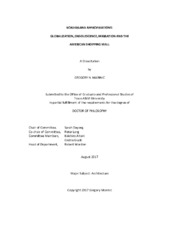| dc.description.abstract | The notion of place embodies a complex intersection of architecture, occupancy, and identity. Tied to geographic and historical conditions, built environments existing between two worlds or within contested territories reveal the underlying political and social forces that have shaped them. Assuming an analogous relationship between consumption and architecture as interconnected systems, this dissertation examines American suburbia in the early twenty-first century to assess convergent flows related to consumption. It engages with the changing nature of retail form, function, and obsolescence to illustrate transnational and technological influences impacting suburban commercial architecture. More specifically, it analyzes occupancies, appropriations, and informal adaptations of retail environments in two distinct regional contexts in North America—the USA-Mexico Borderlands of Texas and the USA-Canada Borderlands of the Eastern Great Lakes region. This research charts the rise, fall, and transformation of the American shopping mall assessed via post-structuralist theories.
Proposing that the obsolete mid-twentieth century shopping mall is a metaphor for the multicultural American city, this study employs dialectical—or comparative— practices to examine conditions which forecast increasing diversity in metropolitan futures. To establish a conceptual framework, two primary theoretical precedents were hybridized in this dissertation—the archival analysis of Walter Benjamin’s seminal The Arcades Project (1927-1940) and the theoretical lens of otherness— or heterotopias—proposed by Michel Foucault in Of Other Places: Utopias and Heterotopias (1984). Furthermore, the terrain vague territorial critique proposed by Ignasi Solà-Morales and the dérives of Guy Debord’s Situationist International influenced similar documentation techniques for suburban shopping malls characterized by marginal—or borderland—national, metropolitan, and social-economic conditions. Unlike most of the existing literature surrounding so-called dead malls, this research does not lament the demise of suburban drosscape or junkspace, but celebrates its incremental translation into an organic, nuanced, and temporal placeholder for actual urbanism. By means of case studies, this dissertation serves as a documentation device that identifies, theorizes, and archives largely ignored everyday suburban structures—transitional spaces of otherness serving the needs of immigrants and historically disadvantaged communities that are routinely demolished due to contemporary market pressures, planning initiatives, and real estate practices. In short, it draws awareness to informal actions that have transformed mid-century American shopping malls into liminal places threatened by gentrification and permanent erasure. | en |


